The Bay Trail Preview: Intel Atom Z3770 Tested
by Anand Lal Shimpi & Brian Klug on September 11, 2013 12:00 PM EST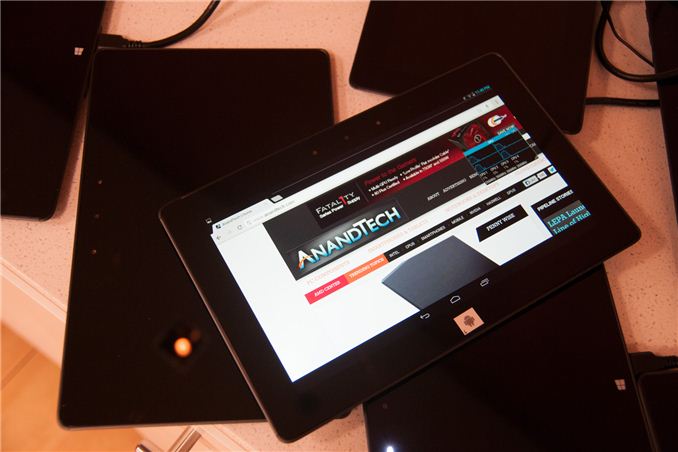
Earlier this year Intel unveiled Silvermont, its first true architectural update to Atom since its introduction in 2008. I won’t rehash Silvermont’s architecture here, but it’s designed to be a true test of Intel’s performance in the ultra mobile space. Leveraging Intel’s first 22nm SoC process and a very low power/efficient microarchitecture, Silvermont aims squarely at the latest Krait cores from Qualcomm and ARM’s Cortex A15.
Today Intel takes the next step forward, introducing the first tablet SoC based on Silvermont: Bay Trail.
Bay Trail takes up to four Silvermont cores, and for the first time in an ultra mobile Intel SoC pairs them with Intel’s own graphics IP. That’s right, rather than using a GPU block from Imagination Technologies, Bay Trail leverages the same GPU architecture as Ivy Bridge.
The first Bay Trail tablets will be shipping by the end of the year, across both Android and Windows 8.1. Intel expects Bay Trail to show up in tablets and 2-in-1s priced below $599, with everything above $599 falling under Haswell’s jurisdiction.
Bay Trail & Branding
Bay Trail, like all Atom platforms before it, will be available in multiple form factors. Unlike the Atoms of yesterday however, the SoC will carry Pentium and Celeron branding when used in notebooks and desktops. Intel didn’t disclose too much about its Silvermont plans in other form factors other than some basic naming:
Basically notebooks ship under the Pentium N3000 & Celeron N2000 series, while desktops will carry Pentium J2000 & Celeron J1000 branding. All Pentium SKUs seem to be quad-core, while Celeron SKUs will be available in both dual and quad-core versions.
Thankfully Intel shied away from introducing the same complexity with its tablet focused Bay Trail parts. All Bay Trail tablet SKUs carry Atom branding. There’s the quad-core Z3700 series and the dual-core Z3600 series.
Although Intel offers both dual and quad-core Bay Trail SKUs, they are both based on the same single physical design. In other words, dual-core Bay Trail parts are just die harvested quad-core parts. Intel isn’t disclosing die size or transistor counts, which is ironic (and disappointing) given that Apple just disclosed both (or at least relative magnitude of one) for its A7 SoC.
Internally, the Bay Trail design is pretty nice. There are either two or four cores enabled, each pair with a shared 1MB L2 cache (2MB total for a quad-core part). Intel is following the unfortunate lead of everyone else in the mobile industry and advertising max turbo frequencies exclusively.
Thankfully Intel hasn’t yet decided to obfuscate max non-turbo frequencies:
| Bay Trail Turbo Speeds | ||||||||
| Z3770 | Z3770D | Z3740 | Z3740D | Z3680 | Z3680D | |||
| Max turbo frequency | 2.39GHz | 2.41GHz | 1.86GHz | 1.83GHz | 2.0GHz | 2.0GHz | ||
| Max non-turbo Frequency | 1.46GHz | 1.5GHz | 1.33GHz | 1.33GHz | 1.33GHz | 1.33GHz | ||
In general you’re looking at 1.33GHz - 1.46GHz max non-turbo frequencies, with Bay Trail being able to turbo up to anywhere between 1.83GHz and 2.40GHz depending on SKU.
Although the core architecture is 64-bit in design, there will be no OS support for 64-bit Bay Trail at launch. Windows 8.1 with Connected Standby appears to still be 32-bit only, and obviously Android is 32-bit only at this point as well.
The memory interface is fairly ridiculous by mobile standards. You either get two 64-bit LPDDR3 channels (128-bit total width) or a single 64-bit DDR3L channel. In the case of the former, that’s the same memory bus width as Apple’s A5X/A6X line of SoCs as well as the standard Core i3/i5/i7 parts. Max supported memory frequency is 1066MHz in dual-channel LPDDR3 mode, or 1333MHz in single-channel DDR3L mode. The only benefit to the latter is really cost, as Bay Trail will purportedly show up in some very cheap devices.
The GPU is Intel’s own Gen7 graphics core, a cut down implementation of what we first saw in Ivy Bridge. I suppose it’s premature to expect Merrifield, Bay Trail’s smartphone counterpart, to also use Intel’s own graphics core but it’s clear this is the direction Intel is headed in - and away from licensing IP from Imagination Technologies.
Rather than 16 EUs in the Ivy Bridge GT2 configuration (HD 4000), Bay Trail’s HD Graphics core ships with 4. The 4 EUs are otherwise effectively identical to what we found in Ivy Bridge. The GPU can dynamically scale frequency and share power between itself and the CPU cores. Minimum GPU frequency on Bay Trail is 311MHz and a max GPU frequency of 667MHz (or 688MHz for the DDR3L SKUs).
Intel is quick to point out that Bay Trail’s GPU supports DirectX 11 and OpenGL ES 3.0. Unfortunately this support list appears limited to Windows. Under Android, it’s unclear whether or not Bay Trail will ship with anything above OpenGL ES 2.0 support. The same goes for GPU accelerated Renderscript. Bay Trail supports up to 2560 x 1440 displays over eDP1.3/DP1.2, or 1080p over HDMI. Panel Self Refresh is also supported.
Video encode and decode blocks also shifted away from Imagination in Bay Trail. Both IP blocks are custom from Intel now. The ISP (Image Signal Processor) is from Silicon Hive (an Intel acquisition).


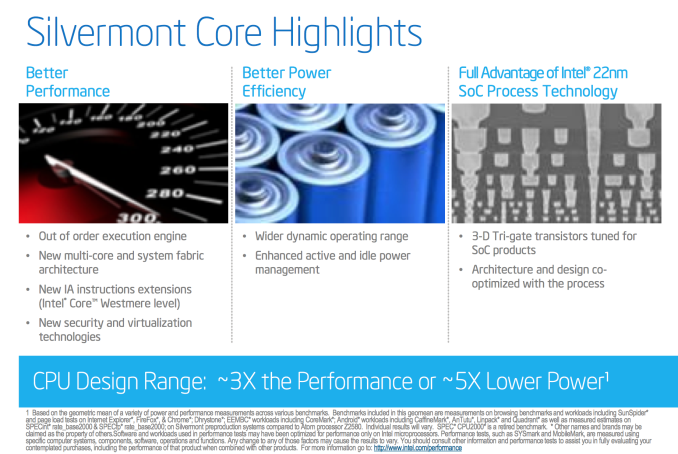
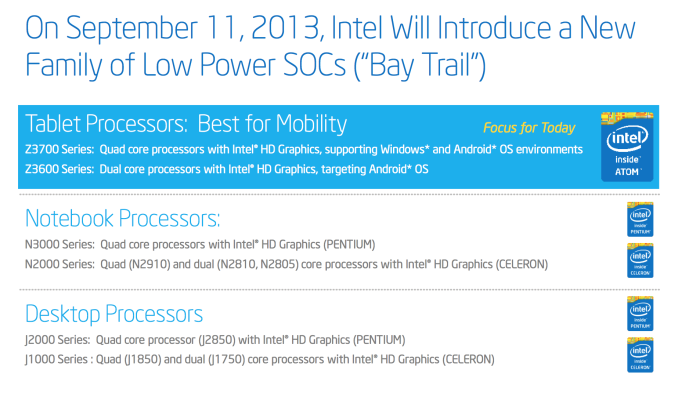
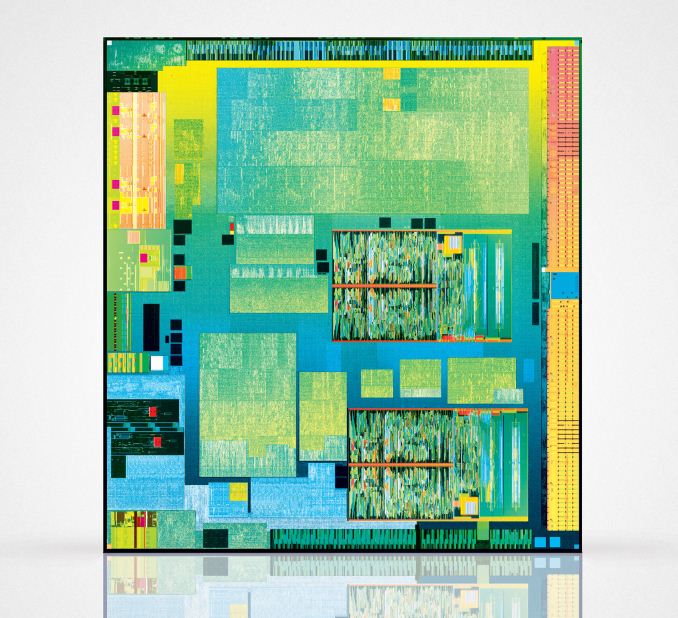
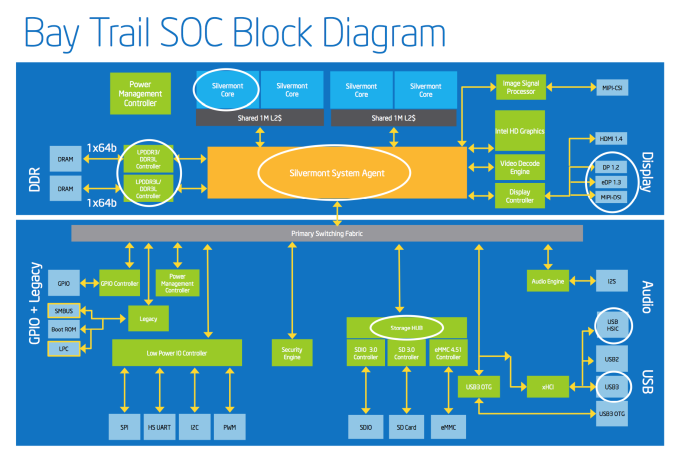
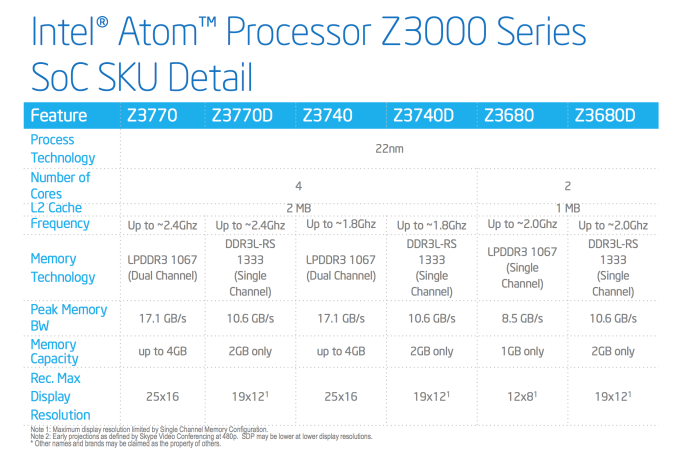
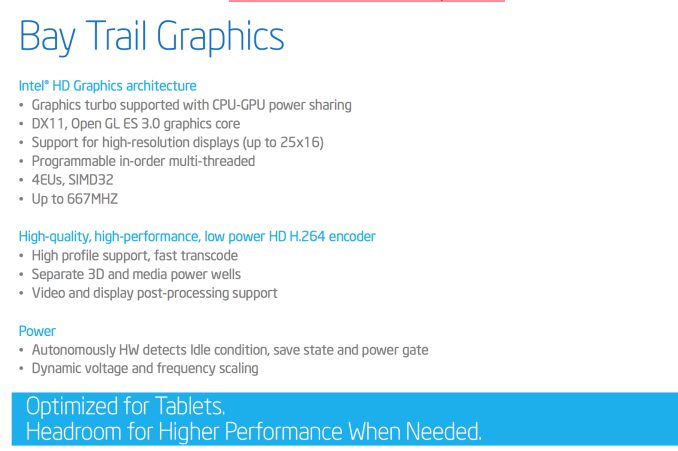
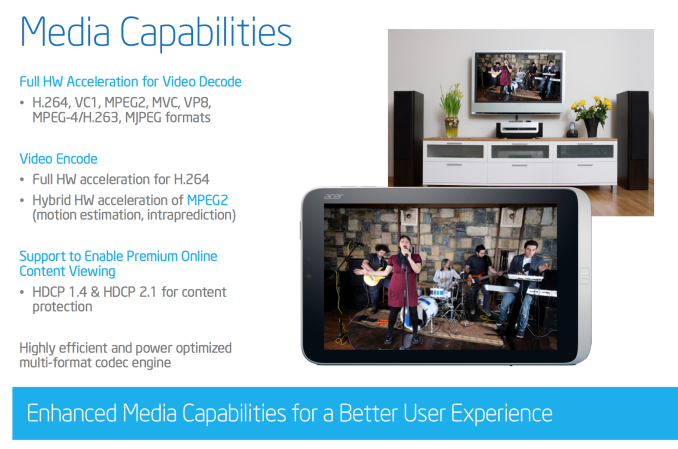








190 Comments
View All Comments
Kidster3001 - Thursday, September 12, 2013 - link
Not to mention that Intel is the largest contributor to AOSP in the world... and has been for a few years now.dwade123 - Wednesday, September 11, 2013 - link
RIP ARM.Anders CT - Wednesday, September 11, 2013 - link
Who do you think will use Bay Trail rather than, say, a Snapdragon in their devices?virtual void - Wednesday, September 11, 2013 - link
Anyone that understands the value of really good single-threaded performance on integer workloads as that is by far the most important property for a tablet would be stupid not to select Bay Trail.Almost every single Android application runs on x86 based Medfield phones, so compatibility with existing Android-applications is a non-issue.
It comes down to price of the device, if the Silvermont based Android tablets end up at roughly the same price, why wouldn't I want the better performing one (battery life seems to be about the same)?
Anders CT - Wednesday, September 11, 2013 - link
I see two problems with this: The apps where single-threaded performance is critical, is the very apps that are likeely to contain optimized native code.Second: I doubt that Bay Trail while be competitive on price, especially if you factor in the apparent lack of on-chip LTE and Wifi modems.
Maybe we will se a lot of Android laptops (I'm writing this on Android laptop with Tegra 4 btw), but on a bigger screen you tend to be pushing a lot of pixels, and then you need a bigger GPU.
I'm not saying that Bay Trail will be a failure. I just don't see a lot of reason for OEMs to jump ship on Qualcomm.
Dentons - Wednesday, September 11, 2013 - link
Intel isn't going to kill ARM. While Intel is finally releasing a product that's competitive with ARM, it's probably five or six years too late. To paraphrase from above, convincing existing ARM vendors to move to Intel will not be an easy task. There will be huge costs involved in any such move.In order to convert ARM customers, Intel would need either far better performance or far better price points, and probably both. It seems unlikely that Intel has either.
Even with these latest chips, Intel's performance is only minimally better than ARM's current offerings, and while we don't know pricing, given that Intel has the highest margins in the industry and ARM among the lowest, one must assume that Intel's new silicon won't be price competitive with ARM.
Further, this chip's stand out feature is its X86 compatibility, something neither of the top mobile operating systems require or desire. ARM also allows mobile manufacturers a large, competitive marketplace from which to purchase CPU's. Were tablet manufacturers to spurn ARM, they'd drop themselves right back into Intel's high-margin arms.
These chips seems specifically designed to kill off Windows RT. In that alone, they'll probably succeed. Gaining real market share from ARM would require robust X86 versions of iOS and Android. While X86 Android does exist, almost entirely due to work by Intel themselves - there are tremendous application issues. Google seems unlikely to do much of the heavy lifting, the development would continue to be almost entirely the responsibility of Intel.
ARM has a massive lead. To keep that lead ARM just needs to stay good enough. ARM can win by staying reasonably competitive with Intel's performance while continuing to destroy them on price. Unless Intel brings both massive performance gains and tremendous price reductions, it won't be worthwhile for the big existing ARM players to lift heaven and earth to support X86.
Intel's only hope is X86 Windows 8 for tablets takes off. Good luck with that. Devices with a full WinTel tax will never be cost competitive with ARM / Android.
zeo - Wednesday, September 11, 2013 - link
Intel already got the ATOM within less than $10 to no more than $20 more than an ARM SoC for the ATOM SoC... And Bay Trail will be priced even lower than the present ATOM!And they already are competitive on power efficiency, leaving performance as the last thing they needed to excel at and Bay Trail looks to get enough for it to count...
Mind, Intel doesn't have to deal with hardware fragmentation as their own driver support for their own GPU is far better than most of the closed drivers used for the proprietary graphics used by the majority of ARM devices.
And people are more used to using desktop Linux on Intel systems anyway... So don't underestimate their chances too much, they're far from terrible...
TheinsanegamerN - Wednesday, September 11, 2013 - link
see, her is the issue. 10-20 bucks more means the chip is wither 50% or 100% more expensive then the competitor, and offers only a small improvement performance wise. add in atom's tainted name, its no wonder that OEMs dont want to use atom as much as, say, qualcomm chips.TheinsanegamerN - Wednesday, September 11, 2013 - link
*here, not herNagorak - Thursday, September 12, 2013 - link
And how exactly do you know that OEMs don't want to use Intel chips? Because the day it's announced there aren't tons of Atom based tablets available in the store?Samsung even used the old Atom in their Galaxy Tab 3, and this Atom is like three times better. The idea that OEMs are going out of their way to avoid Atoms is not reality.